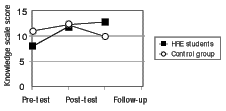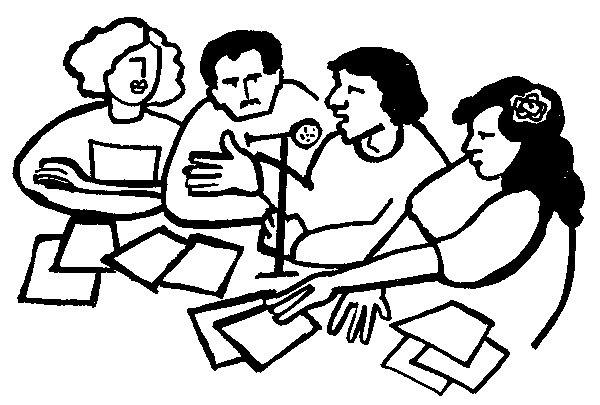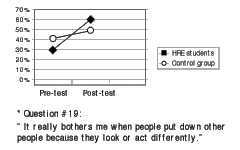
Part I
|
||||||||||||||||
|
Why Human Rights Education?Human rights are highly inspirational and also highly practical, embodying the hopes and ideals of most human beings and also empowering people to achieve them. Human rights education shares those inspirational and practical aspects. It sets standards but also produces change. Effective human rights education can —
Active CitizenshipHuman rights education is essential to active citizenship in a democratic and pluralistic civil society. Citizens need to be able to think critically, make moral choices, take principled positions on issues, and devise democratic courses of action. Participation in the democratic process means, among other things, an understanding and conscious commitment to the fundamental values of human rights and democracy, such as equality and fairness, and being able to recognize problems such as racism, sexism, and other injustices as violations of those values. Active citizenship also means participation in the democratic process, motivated by a sense of personal responsibility for promoting and protecting the rights of all. But to be engaged in this way, citizens must first be informed.
Informed ActivismLearning is also essential to human rights activism. Only people who understand human rights will work to secure and defend them for themselves and others. Peter Benenson, who first envisioned Amnesty International, believed that if people knew about "the forgotten prisoners," they would be moved to action and that publicity campaigns based on accurate evidence would serve as the most effective means of embarrassing repressive governments and thus protecting their citizens. This idea has proved one of the great mobilizing forces of the late twentieth century. Educating the public through reliable, objective, and timely information is a principal strategy of organizations like Amnesty International and Human Rights Watch. Just as civil society depends upon such concerned citizens, human rights organizations depend on informed members. However, even activists are largely self-taught about human rights, informing themselves because they care about an issue, and usually the more they know, the more committed they become to working for change. Recognizing that the better informed the activists, the more effective their activism, human rights organizations must continually educate their members, new and old, not only about issues, but also about the history, mandate, and policies of the organization; how it works; and how to work for it. Furthermore, activists must themselves serve as catalysts for human rights learning in their own schools, workplaces, and neighborhoods.
The Need for Human Rights Education in the United StatesIn 1997 Human Rights USA, a partnership for human rights education, conducted a national survey on the knowledge level and attitudes of people in the USA on human rights. The results showed that only 8% of adults and 4% of young people are aware of and can name the Universal Declaration of Human Rights (UDHR). Although over 90% of the population remains ignorant of the most basic human rights document, every day the media bring human rights crises into living rooms in the US. This contrast speaks graphically of the contemporary disassociation of knowledge and information. The survey also revealed that a large majority (83%) felt that the USA should do more to live up to the principles of the UDHR. Nearly two-thirds (63%) of those polled felt that the poor were routinely discriminated against in US society, as well as the disabled (61%), the elderly (54%), gays and lesbians (61%), Native Americans (50%) and African Americans (41%).11
The Need for Human Rights Education in Local CommunitiesOnce people grasp human rights concepts, they begin to look for their realization in their own lives, examining their communities, families, and personal experience through a human rights lens. In many cases people find these values affirmed, but human rights education can also lead to a recognition of unrealized injustices and discriminations. This sensitization to human rights in everyday life underscores the importance of not only learning about human rights but also learning for human rights: people need to know how to bring human rights home, responding appropriately and effectively to violations in their own communities. See "Taking the Human Rights Temperature of Your School," p. 90, for an example of a survey that can easily be adapted to evaluate the human rights climate of a community or institution.
Does Human Rights Education Work?Evaluation methodologies for human rights education are still in the developmental stage (See Part VI, "Evaluating Human Rights Programs," p. 135), and evidence of its effectiveness are still largely anecdotal, the personal observations of practitioners from both the formal and informal sectors. However, a 1997 study conducted by The Search Institute and Minnesota Advocates for Human Rights yielded impressive concrete results. Cognitive and behavioral outcomes were measured at a Minneapolis public elementary school where some students received no human rights education, some had three lessons a week, and others participated in a program in which human rights were fully integrated into both the curriculum and the culture of the classroom.12 Students' self-report of knowledge on human rights related issues showed marked increase.
Change in self-report of knowledge of human rights and related issues
Furthermore, students self-reported "feelings of concern when others were disparaged because they looked or behaved differently" showed an even greater increase. Changes in self report of feeling bothered when people put down others because of differences* |
| Inappropriate Physical Activity | Inappropriate Verbal | Uncooperative Behavior | |
| No HR Education |
11
|
25
|
14
|
| HRE 3x a week |
4
|
6
|
3
|
| HRE Fully Integrated |
0
|
0
|
0
|
This study documents the success of only a single program, but its impressive results illustrate the need for development in this area of human rights education. Individual educators and organizations believe in the effectiveness of human rights education on the basis of their subjective experiences, but few studies exist in any part of the world to offer concrete, objective evidence. Educators need this information not only to identify effective methodologies and refine their practice, but also to convince decision-makers, such as educational authorities, boards of nongovernmental organizations, and funders, of the efficacy of human rights education. For concrete suggestions on evaluation methodologies see Part VI, "Evaluating Human Rights Programs," p. 135.
THE AUDIENCE FOR HUMAN RIGHTS EDUCATION
Who needs human rights education? The simple answer is, of course, everyone. However, human rights education is especially critical for some groups.
Young children and their parents: Educational research shows conclusively that attitudes about equality and human dignity are largely set before the age of ten. Human rights education cannot start too young. Indeed, some of the most creative and effective human rights educators are found in pre-school and primary classes.
Teachers, principals, and educators of all kinds: No one should be licensed to enter the teaching profession without a fundamental grounding in human rights, especially the Conven tion on the Rights of the Child (CRC). What a difference might be made in children's lives if teachers consistently honored the child's right to express opinions and obtain information (CRC Article 13) or imposed school discipline consistent with the child's human dignity (CRC Article 28).
Veteran teachers present a particular challenge because human rights education involves not only new information, but also introduces attitudes and methodologies that may challenge their accustomed authority in the classroom. Nevertheless, most teachers around the world share a common trait: a genuine concern for children. This motivation and a systematic in-service training program linked to recertification or promotion can achieve a basic knowledge of human rights for all teachers.
Teachers do not work in isolation, however. To succeed, human rights education requires the endorsement and support of the whole educational system, including those who oversee continuing education, who license or certify teachers, who set curriculum standards and content, and who evaluate students, teachers, and schools. These officials are as unlikely as anyone else to have knowledge of human rights, and they too need to achieve "human rights literacy."
Doctors and nurses, lawyers and judges, social workers, journalists, police, and military officials: Some people urgently need to understand human rights because of the power they wield or the positions of responsibility they hold, but even social elites seldom receive human rights education, formally or informally. Human rights courses should be fundamental to the curriculum of medical schools, law schools, universities, police and military academies, and other professional training institutions.
Especially vulnerable populations: Human rights education must not be limited to formal schooling. Many people never attend school. Many live far from administrative centers. Yet they, as well as refugees, minorities, migrant workers, indigenous peoples, the disabled, and the poor, are often among the most powerless and vulnerable to abuse. Such people have no less right to know their rights and far greater need.
Only by working in collaboration with these vulnerable groups can human rights educators develop programs that accommodate their needs and situations. The techniques of popular education—music, street theater, comic books, alternative media, and itinerant storytellers—can help to connect human rights to people's lived experience.
Activists and non-profit organizations: Many human rights activists are not solidly grounded in the human rights framework and many human rights scholars know next to nothing about the strategies of advocacy. Few people working in nongovernmental organizations (NGOs) recognize that they may be engaged in human rights work, and even human rights advocates usually acquire their knowledge and skills by self-teaching and direct experience. Especially in the United States, where social and economic justice is rarely framed in human rights language, many activists who work on issues like fair wages, health care, and housing fail to understand their work in a human rights context or recognize their solidarity with other workers for social and economic justice.
Public office holders, whether elected or appointed: In a democracy no one can serve the interests of the people who does not understand and support human rights. People should require all candidates for election, from the head of state to the local council member, to make a public commitment to human rights. And human rights should be included in the orientation of all new office holders.
Power holders: This group includes members of the business and banking community, landowners, traditional and religious leaders, and anyone whose decisions and policies affect many peoples' lives. As possessors of power, they are often highly resistant, regarding human rights as a threat to their position and often working directly or indirectly to impede human rights education. To reach those in power, human rights need to be presented as benefiting the community and themselves, offering long-term stability and furthering development. To avoid misperceptions of the goals and content of human rights education, facilitators might arrange a presentation for community leaders or invite them to observe a workshop in session.

11 For details on the Human Rights USA study conducted
by Peter D. Hart Associates, go to http://www.hrusa.org.
12 For details on the HRE study conducted by the
Minnesota Advocates for Human Rights and the Search Institute,go to
http://www.hrusa.org.
13 For this study inappropriate behaviors were defined
as follows:
1. Inappropriate Physical Behavior: spitting, hitting, choking, jeers, pinching, scratching, hand gestures, writing on other's work, throwing objects, drumming, pulling hair, out-of-place and striking with objects.
2. Inappropriate Verbal Displays: Swearing or using vulgar language, talking too loudly, racial or sexist slurs, taunting, booing, talking back, arguing, complaining, or interrupting
3. Uncooperative Behavior: refusing to obey or follow rules, acting defiantly or pouting, refusing to take turns or share, cheating and lying.

